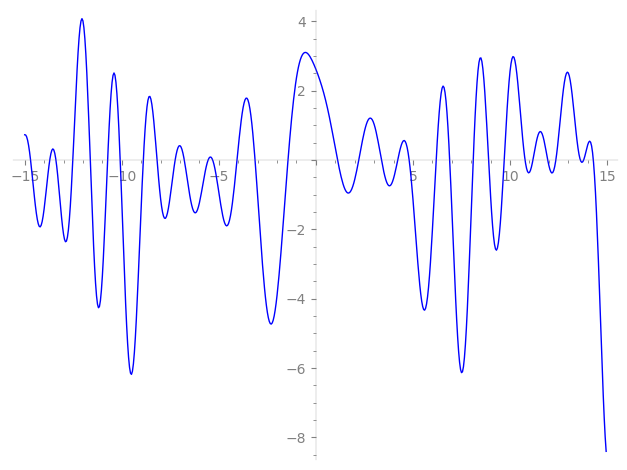| L(s) = 1 | + (0.911 + 1.57i)2-s + (−0.661 + 1.14i)4-s + (−0.216 + 0.374i)5-s + (0.345 + 0.598i)7-s + 1.23·8-s − 0.789·10-s + (1.26 + 2.19i)11-s + (3.60 − 6.23i)13-s + (−0.629 + 1.09i)14-s + (2.44 + 4.23i)16-s − 4.46·17-s + 6.05·19-s + (−0.286 − 0.495i)20-s + (−2.31 + 4.00i)22-s + (−2.05 + 3.56i)23-s + ⋯ |
| L(s) = 1 | + (0.644 + 1.11i)2-s + (−0.330 + 0.572i)4-s + (−0.0967 + 0.167i)5-s + (0.130 + 0.226i)7-s + 0.436·8-s − 0.249·10-s + (0.382 + 0.662i)11-s + (0.998 − 1.73i)13-s + (−0.168 + 0.291i)14-s + (0.611 + 1.05i)16-s − 1.08·17-s + 1.38·19-s + (−0.0640 − 0.110i)20-s + (−0.492 + 0.853i)22-s + (−0.428 + 0.742i)23-s + ⋯ |
\[\begin{aligned}\Lambda(s)=\mathstrut & 1161 ^{s/2} \, \Gamma_{\C}(s) \, L(s)\cr =\mathstrut & (-0.116 - 0.993i)\, \overline{\Lambda}(2-s) \end{aligned}\]
\[\begin{aligned}\Lambda(s)=\mathstrut & 1161 ^{s/2} \, \Gamma_{\C}(s+1/2) \, L(s)\cr =\mathstrut & (-0.116 - 0.993i)\, \overline{\Lambda}(1-s) \end{aligned}\]
Particular Values
| \(L(1)\) |
\(\approx\) |
\(2.618690120\) |
| \(L(\frac12)\) |
\(\approx\) |
\(2.618690120\) |
| \(L(\frac{3}{2})\) |
|
not available |
| \(L(1)\) |
|
not available |
\(L(s) = \displaystyle \prod_{p} F_p(p^{-s})^{-1} \)
| $p$ | $F_p(T)$ |
|---|
| bad | 3 | \( 1 \) |
| 43 | \( 1 + (-0.5 - 0.866i)T \) |
| good | 2 | \( 1 + (-0.911 - 1.57i)T + (-1 + 1.73i)T^{2} \) |
| 5 | \( 1 + (0.216 - 0.374i)T + (-2.5 - 4.33i)T^{2} \) |
| 7 | \( 1 + (-0.345 - 0.598i)T + (-3.5 + 6.06i)T^{2} \) |
| 11 | \( 1 + (-1.26 - 2.19i)T + (-5.5 + 9.52i)T^{2} \) |
| 13 | \( 1 + (-3.60 + 6.23i)T + (-6.5 - 11.2i)T^{2} \) |
| 17 | \( 1 + 4.46T + 17T^{2} \) |
| 19 | \( 1 - 6.05T + 19T^{2} \) |
| 23 | \( 1 + (2.05 - 3.56i)T + (-11.5 - 19.9i)T^{2} \) |
| 29 | \( 1 + (-3.23 - 5.59i)T + (-14.5 + 25.1i)T^{2} \) |
| 31 | \( 1 + (-1.26 + 2.19i)T + (-15.5 - 26.8i)T^{2} \) |
| 37 | \( 1 + 9.14T + 37T^{2} \) |
| 41 | \( 1 + (-0.455 + 0.788i)T + (-20.5 - 35.5i)T^{2} \) |
| 47 | \( 1 + (4.79 + 8.30i)T + (-23.5 + 40.7i)T^{2} \) |
| 53 | \( 1 - 8.85T + 53T^{2} \) |
| 59 | \( 1 + (6.51 - 11.2i)T + (-29.5 - 51.0i)T^{2} \) |
| 61 | \( 1 + (0.396 + 0.687i)T + (-30.5 + 52.8i)T^{2} \) |
| 67 | \( 1 + (5.69 - 9.87i)T + (-33.5 - 58.0i)T^{2} \) |
| 71 | \( 1 - 13.2T + 71T^{2} \) |
| 73 | \( 1 + 4.01T + 73T^{2} \) |
| 79 | \( 1 + (-5.94 - 10.2i)T + (-39.5 + 68.4i)T^{2} \) |
| 83 | \( 1 + (4.88 + 8.45i)T + (-41.5 + 71.8i)T^{2} \) |
| 89 | \( 1 + 8.04T + 89T^{2} \) |
| 97 | \( 1 + (7.49 + 12.9i)T + (-48.5 + 84.0i)T^{2} \) |
| show more | |
| show less | |
\(L(s) = \displaystyle\prod_p \ \prod_{j=1}^{2} (1 - \alpha_{j,p}\, p^{-s})^{-1}\)
Imaginary part of the first few zeros on the critical line
−10.08020915296801738853820623375, −8.889736856468272363261700910972, −8.181503245136075735634534528304, −7.25004089214548160865426580644, −6.77928329576244070556172431167, −5.55256185586444929401619472155, −5.31705635374453577169453327608, −4.06378639849824508517890689999, −3.13470834344848261109584929125, −1.43694833603509863066043461071,
1.11651918876402354622401903036, 2.20739736242977617560300470939, 3.37770852428936416065557194070, 4.21447253291733874191502502062, 4.80372472903814319901636737180, 6.19501673001010614673004707150, 6.89050226601464033366551317921, 8.102185700455135598508365816328, 8.896118405329336237245710217510, 9.698608076592187532019328535212

